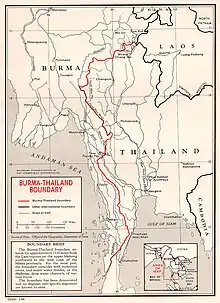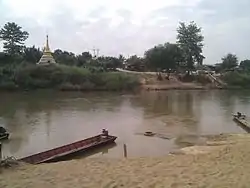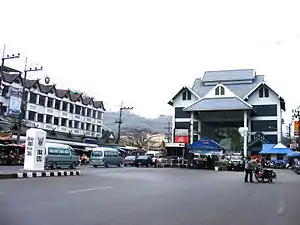Myanmar–Thailand border
The Myanmar–Thailand border is the international border between the territory of Myanmar (formerly Burma) and Thailand. The border is 2,416 km (1,501 m) in length and runs from the tripoint with Laos in the north to Andaman Sea coast in the south.[1]

Description
The border starts in the north at the tripoint with Laos at the confluence of the Kok and Mekong Rivers and, after briefly following the Kok and then the Sai, then proceeds overland to the west via a series of irregular lines through the Daen Lao Range, before turning to the south-west and joining the Salween River. The border follows the Salween and then Moei River southwards, before leaving it and proceeding southwards overland through the Dawna Range and Bilauktaung Range (collectively these mountains form the Tenasserim Hills). The border continues southwards down the Malay Peninsula, almost cutting Thailand in two at Prachuap Khiri Khan, before reaching the Isthmus of Kra and the Kraburi River, which it then follows out via a wide estuary to the Andaman Sea. The maritime boundary then follows coordinates marked by the countries' continental shelf delimitation agreement towards the tripoint with India, which controls the Andaman and Nicobar Islands.
History

The border regions have historically been contested between the various Thai and Burmese states.[2] Fighting between Burma and the Siamese Ayutthaya Kingdom over control of what is now Myanmar's Tanintharyi Region dominated the area in the 16th century, before Burma destroyed Ayutthaya and took control of the region in 1767.[2] Soon after, Siam extended suzerainty over the Lanna Kingdom (now Northern Thailand), which had previously been under Burmese control. Burmese expansion in the 19th century brought it into conflict with the British in India, sparking a series of conflicts which ended with Burma being occupied and incorporated into British India.[2] With France occupying French Indochina in the same period, the two European states allowed the Kingdom of Siam (the old name for Thailand) to retains its independence as a buffer state.[3][4]
In 1868 Britain and Siam signed a treaty delimiting the Burma-Thai border from the Salween south to the Andaman Sea.[2] Following some confusion as to the border's location, on the ground demarcation of the border commenced from 1889–92.[2] In 1892 the northern section of the border delimited and then demarcated on the ground from 1893–94, with a final boundary treaty with maps signed on 17 October 1894.[2] The northern terminus of the border was fixed in 1896 when the British and French agreed that the Mekong would serve as the Burma-Laos border.[2] Some minor boundary adjustments occurred in 1929 and 1934.[2] In 1941, following Japan's invasion of Burma, parts of Burma were ceded to Siam as the Saharat Thai Doem territory, however these areas were returned to Burma in 1946 following Japan's defeat and since then the border has remained in place.[2][5][6] In 1937 Burma was separated from India and became a separate colony, gaining full independence in 1948, at which point the border became an international frontier between two sovereign states.[2]
At present there is an outstanding dispute over the ownership of some small islands in the Andaman Sea.[7]
From 2010-12 there were clashes along the border between the Myanmar army and the Karen National Liberation Army.[8][9]
Border crossings

There are several border crossings:[10][11][12]
- Mae Sot - Myawaddy
- Mae Sai - Tachilek
- Ban Sop Ruak - Chiang Saen
- Ranong - Kawthaung
- Phu Nam Ron - Htee Kee
- Singkhon Pass - Maw Daung (the Singkhon Pass)
- Sangkhla Buri - Payathonzu (the Three Pagodas Pass)
- Bong Ti - Sinbyudaing
- Nong Uk - Namaklwe
Gallery
 Border bridge at Kawthaung
Border bridge at Kawthaung The border along the Moei river, with Myanmar on the opposite bank
The border along the Moei river, with Myanmar on the opposite bank Border gate at Mae Sai
Border gate at Mae Sai The border bridge at Tachilek
The border bridge at Tachilek Mae Sot border crossing
Mae Sot border crossing Border control gate at Dan Sing Khon
Border control gate at Dan Sing Khon
See also
References
- "Burma". CIA World Factbook. Retrieved 19 September 2020.
- "International Boundary Study No. 63 – Burma – Thailand Boundary" (PDF). US Department of State. 1 February 1966. Retrieved 19 September 2020.
- Pholsena, Vatthana (2007). LAOS, From Buffer State to Crossroads. Silkworm Books. ISBN 978-9749480502.
- Macgregor, John (1994). Through the Buffer State : Travels in Borneo, Siam, Cambodia, Malaya and Burma. White Lotus Co Ltd; 2 edition. ISBN 978-9748496252.
- Donald M. Seekins, Historical Dictionary of Burma (Myanmar), p. 251
- "A Forgotten Invasion: Thailand in Shan State, 1941–45"
- Sophal, Sek (13 January 2020). "New subs sign of troubles to come?" (Opinion). Bangkok Post. Retrieved 13 January 2020.
- "Thousands flee Myanmar clashes". Al Jazeera. 8 November 2010. Retrieved 9 November 2010.
- "Civil war threatens following Burma's election". ABC News. November 9, 2010. Retrieved 9 November 2010.
- Pattaya Mail - Dan Sing Khon border crossing upgrade under way
- "ARRIVING AND DEPARTING OVER LAND". GoMyanmar. Retrieved 19 September 2020.
- "How to Cross the Border Between Myanmar and Thailand". World Nomads. Retrieved 19 September 2020.
| Wikimedia Commons has media related to Myanmar-Thailand border. |